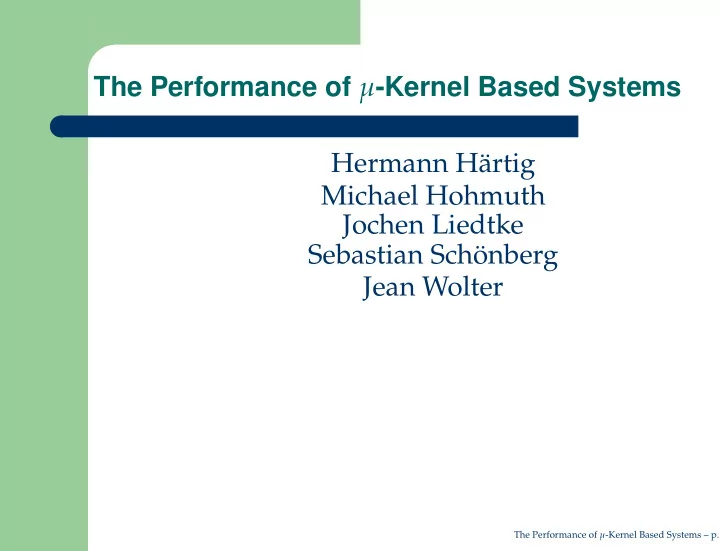

The Performance of µ -Kernel Based Systems Hermann Härtig Michael Hohmuth Jochen Liedtke Sebastian Schönberg Jean Wolter The Performance of µ -Kernel Based Systems – p.
Introduction � µ -kernels have reputation for being too slow, inflexible � can 2nd generation µ -kernel (L4) overcome limitations? � Experiment: port Linux to run on L4 and compare it to: � native Linux � MkLinux (Linux on 1st gen Mach derived µ -kernel) The Performance of µ -Kernel Based Systems – p.
Introduction � test speed of standard OS personality on top o fast µ -kernel: Linux implemented on L4 � test extensibility of system: � pipe-based communication implemented directly on µ -kernel � mapping-related OS extensions implemented as user tasks � user-level real-time memory management implemented � test if L4 abstractions independent of platform The Performance of µ -Kernel Based Systems – p.
L4 Essentials � built on threads and address spaces � recursive construction of address spaces by user-level servers � initial address space σ 0 represents physical memory � owner of address space can grant or map page to another address space � all address spaces maintained by user-level servers ( pagers ) The Performance of µ -Kernel Based Systems – p.
Linux on Top of L4 goals to keep porting effort low: � avoid structural changes to Linux � don’t tune Linux to µ -kernel � bonus: new versions of Linux easily adapted system The Performance of µ -Kernel Based Systems – p.
L4Linux Design and Implementation � fully binary compliant with Linux/X86 � restricted modifications to architecture-dependent part of Linux � no Linux-specific modifications to L4 kernel � single Linux server task � Linux server requests memory from σ 0 , acts as pager for user processes The Performance of µ -Kernel Based Systems – p.
L4Linux Design and Implementation The Performance of µ -Kernel Based Systems – p.
L4Linux Design and Implementation � L4 maps hardware interrupts to messages � Linux top-half handlers implemented as threads waiting for messages The Performance of µ -Kernel Based Systems – p.
L4Linux Design and Implementation 3 system call interfaces: � modified version of standard libc.so which uses L4 IPC � modified version of standard libc.a which uses L4 IPC � “trampoline” which emulates native system-call trap (slower, but full binary compatibility) The Performance of µ -Kernel Based Systems – p.
L4Linux Design and Implementation � 6500 new lines of code written � 14 engineer-months to build L4Linux � regularly use applications such as X Windows Emacs, Netscape, X-Pilot The Performance of µ -Kernel Based Systems – p. 10
Compatibility Performance � What is penalty of using L4Linux instead of native Linux? � Does performance of underlying µ -kernel matter? � How much does co-location improve performance? � microbenchmarks: analyze detailed behavior � macrobenchmarks: measure overall system performance The Performance of µ -Kernel Based Systems – p. 11
Microbenchmarks � measure system call overhead on shortest system call ( getpid() ) The Performance of µ -Kernel Based Systems – p. 12
Microbenchmarks � lmbench measures basic operations like system calls, context switch, pipe operations, network operation The Performance of µ -Kernel Based Systems – p. 13
Macrobenchmarks � measured time to recompile Linux server The Performance of µ -Kernel Based Systems – p. 14
Macrobenchmarks � AIM multiuser benchmark VII (measures system performance under different loads) The Performance of µ -Kernel Based Systems – p. 15
Macrobenchmarks The Performance of µ -Kernel Based Systems – p. 16
Analysis � L4 comes close to performance of native Linu even under high load (5%-10%) � performance of underlying µ -kernel matters � co-location is not sufficient to overcome performance deficiencies The Performance of µ -Kernel Based Systems – p. 17
Recommend
More recommend